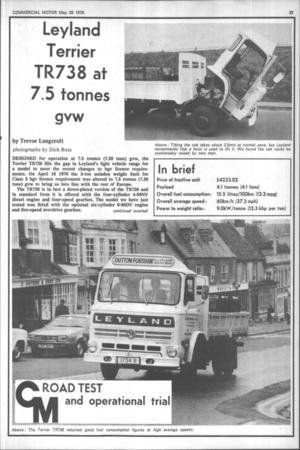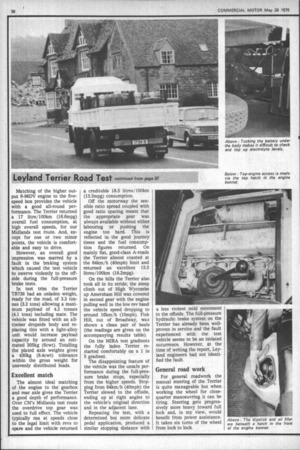Leyland Terrier TR738 at 7.5 tonnes gvw
Page 39

Page 40

Page 41

If you've noticed an error in this article please click here to report it so we can fix it.
by Trevor Longcroft
photographs by Dich Ross DESIGNED for operation at 7.5 tonnes (7.38 tons) gvw, the Terrier TR738 fills the gap in Leyland's light vehicle range for a model to meet the recent changes to hgv licence requirements. On April 16 1976 the 3-ton unladen weight limit for Class 3 hgv licence requirement was altered to 7.5 tonnes (7.38 tons) gvw to bring us into line with the rest of Europe.
The TR738 is in fact a down-plated version of the TR750 and in standard form it is offered with the four-cylinder 4-98NV diesel engine and four-speed gearbox. The model we have just tested was fitted with the optional six-cylinder 6-98DV engine and five-speed overdrive gearbox. continued overleaf Matching of the higher output 6-98DV engine to the fivespeed box provides the vehicle with a good all-round performance. The Terrier returned a 17 litre/100km (16.6mpg) overall fuel consumption, at high overall speeds, for our Midlands test route. And, except for one or two minor points, the vehicle is comfortable and easy to drive.
However, an overall good impression was marred by a fault in the braking system which caused the test vehicle to swerve violently to the offside during the full-pressure brake tests.
In test trim the Terrier TR738 had an unladen weight, ready for the road, of 3.3 tonnes (3.2 tons) allowing a maximum payload of 4.2 tonnes (4.1 tons) including mate. The vehicle was fitted with an alltimber dropside body and replacing this with a light-alloy unit would increase payload capacity by around an estimated 305kg (6cwt). Totalling the plated axle weights gives a 430kg (8.4cwt) tolerance within the gross weight for unevenly distributed loads.
Excellent match
The almost ideal matching of the engine to the' gearbox and rear axle gives the Terrier a good depth of performance. Over CM's Midlands test route the overdrive top gear was used to full effect. The vehicle typically ran at speeds close to the legal limit with revs to spare and the vehicle returned a creditable 18.5 litres/100km (15.3mpg) consumption.
Off the motorway the sensible ratio spread coupled with good ratio spacing meant that the appropriate gear was always available without either labouring or pushing the engine too hard. This is reflected in the good journey times and the fuel consumption figures returned. On mainly flat, good-class A-roads the Terrier almost coasted at the 64km/h (40mph) limit and returned an excellent 15.5 litres/100km (18.2mpg).
On the hills the Terrier also took all in its stride; the steep climb out of High Wycombe up Amersham Hill was covered in second gear with the engine pulling well in the low rev band the vehicle speed dropping to around 16km/h (10mph). Fish Hill, out of Broadway, was shown a clean pair of heels (the readings are given on the accompanying results table).
On the MIRA test gradients the fully laden Terrier restarted comfortably on a 1 in 5 gradient.
The disappointing feature of the vehicle was the unsafe performance during the full-pressure brake stops, especially from the higher speeds. Stopping from 64km/h (40mph) the Terrier slewed to the offside, ending up at right angles to the vehicle's original direction and in the adjacent lane.
Repeating the test, with a determined but more delicate pedal application, produced a similar stopping distance with a less violent mild movement to the offside. The full-pressure hydraulic brake system on the Terrier has already been wellproven in service and the fault experienced with the test vehicle seems to be an isolated occurrence. However, at the time of writing the report, Leyland engineers had not identified the fault.
General road work
For general roadwork the manual steering of the Terrier is quite manageable but when working the wheel for closequarter manoeuvring it can be tiring. Steering gets progressively more heavy toward full lock and, in my view, would benefit from power assistance. It takes six turns of the wheel from lock to lock. From the driving seat there is little to fault. The apperance of the instruments may be dated, but nevertheless the instrument panel is neatly arranged with the gauges clearly visible through the steering wheel.
The major and minor controls are within driver reach, though more prudent location of the ignition switch could save unnecessary driver injury should he be thrown forward in an accident.
Hydraulic dampers were fitted to the front and the rear axle of the test vehicle and the ride over all types of road surface was good. When making quick direction changes such as when taking a roundabout there was no perceptible vehicle roll.
Cab comfort
The approach to cab design and layout is simple but functional. And although the engine bonnet does protrude slightly beyond the seat line, across-cab movement is not hindered.
The driving seat is comfortable and the cab is set low enough to make hopping in and Out easy. I liked the relative positioning of the major controls and the driver's seat and quickly found a "just right" driving position.
Although not as quiet as some of its competitors that I have driven the Terrier was not uncomfortably noisy. Cruising at 64km/h (40mph) in top gear the vehicle was pleasantly quiet with the noise level lifting when the engine was pulling hard or had only a light load.
Although fitted with a tilt cab, engine access can be had by lifting the bonnet between the driver and passenger seat. It would seem that an easier and more refined method of tilting the cab is required— and when it is the bonnet arrangement can be forgotten.
To tilt the cab the driver/ mechanic has to undo two bolts and either a hoist or two men is required for the lift. Inside the cab, the top section of the bonnet is held by a simple catch, but to get to the fanbelt the forward cover must be removed and this is held by seven bolts—a couple of overcentre clips would suffice.
As tested, the Terrier TR738 costs £4,233.02. Basic price for the six-cylinder version is £4,074 with £108, £16.32, £15 and £21.70 being added for the five-speed gearbox, 123-litre and dual passenger seat respectively.




















































































